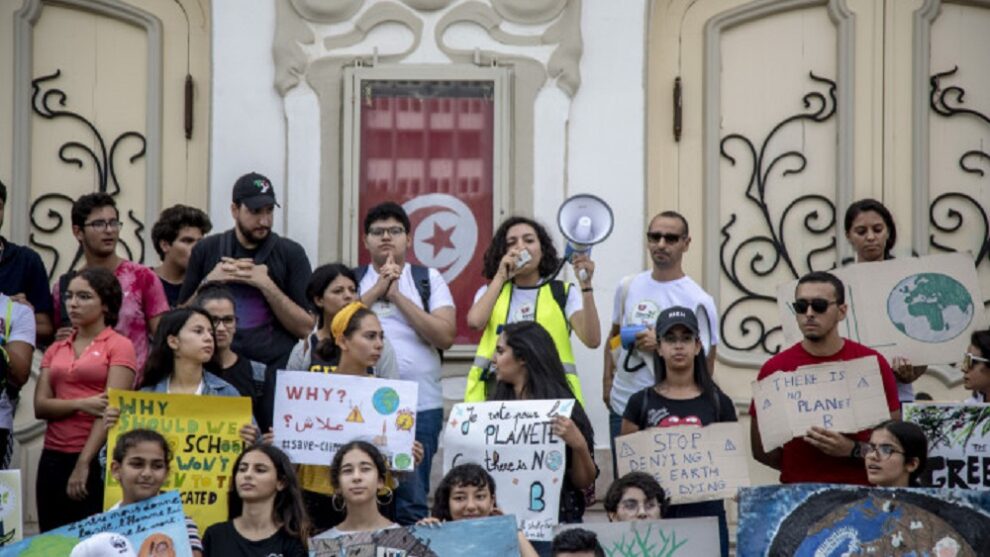Climate change and political turmoil have short-circuited Tunisia’s energy sector, with blackouts disrupting the state’s infrastructure and services.
Tunisia already offers two cautionary tales: what happens when a promising new democracy backslides, and how the consequences of the Western world’s greenhouse gas emissions and climate change are going to look for the Global South.
Climate change continues to pound Tunisia and its neighbours with extreme weather as an autocratic president chips away at the freedoms that Tunisians won during their decade-old revolution.
But a parallel nightmare, unfolding away from much of the news media but quite familiar to developing countries, is exacting its own toll on Tunisians already weary from constitutional crises and natural disasters: an energy shortage.
“The higher Tunisia’s temperatures rise in the coming years, the bigger the risk to the country’s beleaguered electrical grid”
On September 20, a several-hour power blackout struck the entirety of Tunisia. The country’s government at first appeared caught off guard, with Tunisian Interior Minister Kamal Feki heading to Tunisia’s primary power plant in the city of Radès, near Tunis, to find the reason.
The Tunisian Electricity and Gas Company, a state-owned enterprise better known as “STEG,” later attributed the power outage to “technical dysfunction,” with Mounir Ghabri, a STEG spokesman, adding, “The cause is purely technical and has nothing to do with any explosion.”
A number of foreign news agencies covering the September 20 episode described blackouts in Tunisia as “rare.” The local press, however, has provided a more complicated picture, with the website Tunisie Numérique recording a series of power failures in recent years.
In July 2019, much of the inland city of Medenine lost electricity in an incident that STEG blamed on a heat wave and the overuse of air conditioning. The following January, power outages hit homes and hotels in a town in Bizerte Governorate after the theft of a STEG generator resulted in a fire.
And that April, an unspecified technical issue caused power loss across Kasserine Governorate. Blackouts have stopped Tunis’ tram in its tracks, bedeviled bakeries throughout Tunisia, and even killed a COVID-19 patient and harmed two others after power loss to ventilators. STEG has at times appeared all but helpless in its fight against the problem, announcing power cuts in Monastir Governorate in June 2022 and Sousse Governorate in January 2023.
Notwithstanding the varied causes of Tunisia’s power outages, climate change looks set to make them worse. This summer, a heat wave strained Tunisia’s power grid, compelling STEG to institute blackouts in much of the country. Temperatures reached as high as 50 degrees Celsius, roiling vital industries from olive oil to wine and accelerating the wildfires that struck five Tunisian governorates. Yet the threat to infrastructure as fundamental as the power grid stands out.
The higher Tunisia’s temperatures rise in the coming years, the bigger the risk to the country’s beleaguered electrical grid. The United States Agency for International Development’s 2018 “climate risk profile” for Tunisia noted, “During the last 30 years temperature increased by an average of 0.4°C per decade; the mean average temperature rose by 1.4°C in the 20th century.”
The fact sheet added: “Annual maximum temperature is likely to increase by 1.5°C to 2.5°C by 2030 and 1.9°C to 3.8°C by 2050, while annual minimum temperature is likely to rise from 0.9°C to 1.5°C by 2030 and from 1.2°C to 2.3°C by 2050. The number of hot days is projected to increase by about 1.3 days per year between 2020 and 2039 and the duration of heatwaves is likely to increase by 4 to 9 days by 2030 and by 6 to 18 days by 2050.”
Tunisia’s political turmoil has hardly helped matters. Plans to reform STEG by, for example, increasing its use of renewable energy have moved at a snail’s pace amid ongoing clashes between Tunisia’s powerful trade unions and its mercurial president, Kais Saied.
The president, who has unwound many of Tunisia’s democratic gains and concentrated most decision-making power under himself since coming to office in 2019, fired STEG chief executive Hichem Anane in the aftermath of September’s nationwide power outage, contributing to the chaos.
In the World Bank’s own “climate risk country profile” for Tunisia, the international organisation offered indirect criticism of Saied’s energy policies, observing: “While Tunisia has planned to increase its renewable energy consumption by up to 30% by 2030, infrastructure and investment have yet to keep pace with these goals.”
Meanwhile, researchers affiliated with the Bertelsmann Stiftung, a German foundation, have faulted STEG for preventing the private sector from making its own investments in renewable energy.
Noting how “the existing infrastructure and generation capabilities are ill-prepared to cope with the projected effects of climate change and the increased demand,” the World Bank has urged Tunisia to “continue towards the development and implementation of innovative new regulatory and finance models to increase efficiency, especially for utilities and, ultimately implement customer energy savings programs and new approaches to the delivery of electricity, including renewable energies.”
While climate change is hardly Tunisia’s responsibility alone, the country’s political dysfunction has likely exacerbated the challenges facing its electrical grid. Reforms to the political system, then, may pave the way to addressing the underlying causes of Tunisia’s power outages. But whether Saied is willing to make these changes is another matter altogether.
Source : The New Arab





Add Comment